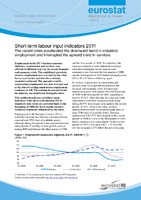| dc.description.abstract | Employment in the EU’s business economy (industry, construction and services) was affected in different ways by the recent financial and economic crisis: The established growth in services employment was reversed by the crisis but several service activities have already recorded a rebound. The upward trend in construction employment was also reversed and at the time of writing construction employment continues to fall. The existing downward trend for industry was reinforced during the crisis. This publication focuses on labour input indicators from short-term statistics (STS). Quarterly time series are provided back to the beginning of 2000 but focus mainly on more recent developments influenced by the crisis. Employment in the European Union’s (EU’s) industrial economy has been on a downward trend since at least 1996 (start of available series), although during this period it has experienced some short periods of stability or even growth, such as during 2000 and between the third quarter of 2006 and the first quarter of 2008. Nevertheless, this long-term reduction in the industrial workforce intensified during the recent financial and economic crisis: between the first quarter of 2008 and the third quarter of 2010 industrial employment fell by 11.4 % before stabilising again. In contrast, employment in construction and services were on an upward trend prior to the financial and economic crisis. Construction employment grew each quarter from the beginning of 2004 to the first quarter of 2008, expanding in total by 15.0 %. After this date the reduction in the construction workforce was particularly sharp, falling 16.9 % from its pre-crisis peak to the second quarter of 2011. Prior to the crisis, services employment had been on an upward path since at least 1998 (start of available series). Services employment fell 3.9 % from its peak in the second quarter of 2008 to a low in the first quarter of 2010 before returning to its upward path: by the second quarter of 2011 it had grown by 1.1 % from this low but remained 2.8 % below the pre-crisis peak. |

